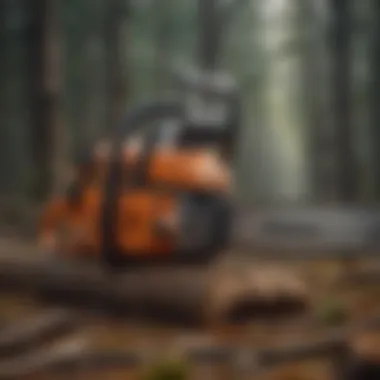Understanding Hydraulic Driven Chainsaws: A Comprehensive Guide


Intro
Hydraulic driven chainsaws represent a significant advancement in forestry and woodcutting technology. These specialized tools utilize hydraulic power to enhance cutting efficiency, making them integral for specific applications in forest management. Their design and operational principles differ notably from traditional gasoline-powered chainsaws, positioning them as a superior option in certain scenarios.
In this article, we will delve into the intricacies of hydraulic driven chainsaws. We will discuss their mechanics, benefits, and limitations, offering valuable insights for forestry professionals and academics. By understanding the technology behind these tools, users can make informed decisions on their applications in the management and conservation of American forests.
Increased interest in sustainable forestry and efficient maintenance of ecosystems has led to a focus on tools that reduce environmental impact. Hydraulic driven chainsaws are at the forefront of this movement, offering features that align with modern ecological practices.
Ultimately, this exploration will provide a clearer picture of how hydraulic driven chainsaws fit into broader forestry practices and the implications for sustainable management.
Preface to Hydraulic Driven Chainsaws
Many users benefit from hydraulic chainsaws in terms of performance efficiency and reduced environmental impact. Because these chainsaws utilize hydraulic power, they often require less physical effort, making them easier to handle over extended periods. Furthermore, using hydraulic systems minimizes emissions compared to internal combustion engines. Hence, these tools align with growing environmental consciousness in forestry practices.
The increased capability and versatility of hydraulic chainsaws make them suitable for a variety of tasks such as timber harvesting, tree removal, and even in emergencies after storms or disasters. However, becoming acquainted with their operation involves understanding specific technical elements and their historical developments.
Definition and Overview
Hydraulic driven chainsaws are specialized cutting tools that operate using hydraulic power rather than traditional fuel or electricity. These machines utilize hydraulic fluid under pressure to drive a motor that controls the chainsaw blade. The hydraulic system allows for greater torque and cutting force, making it possible to cut through tougher materials with less effort.
Typically, a hydraulic chainsaw consists of a blade, hydraulic pump, and a motor. The efficiency of the hydraulic system is a crucial factor for its performance. Users can adjust the flow and pressure of the hydraulic fluid to optimize cutting performance based on material characteristics and cutting needs.
Historical Background
The advent of hydraulic powered tools can be traced back to the mid-20th century, as technology evolved to leverage hydraulic principles for greater efficiency and power. The introduction of hydraulic chainsaws began as an innovation designed to meet the challenges of forestry work. Early models were primarily used in heavy-duty applications, where the strength of hydraulic systems could be best utilized.
Over time, innovations in hydraulic technology have led to advancements in chainsaw design, allowing for more compact and lighter models that could be used by professionals and enthusiasts. As forestry practices evolved and environmental considerations became more prominent, the demand for more efficient and eco-friendly tools increased. Hydraulic chainsaws have gained recognition in contemporary forestry as essential tools that reflect the marriage of technology and sustainable practices.
Technical Specifications
Components of Hydraulic Chainsaws
Hydraulic chainsaws consist of several key components, each playing a vital role in their operation.
- Hydraulic motor: This component converts hydraulic energy into mechanical energy, enabling the chain to move and cut effectively.
- Saw chain: Designed for cutting wood, the saw chain's link arrangement contributes to the efficiency and speed of the cut.
- Guide bar: It supports the saw chain, providing a stable surface for the cutting action while ensuring precise control.
- Hydraulic fluid reservoir: This is essential for storing the hydraulic fluid, which powers the system and allows for efficient energy transfer.
- Pump: A hydraulic pump is essential to circulate the hydraulic fluid throughout the system, generating the pressure needed for operation.
Each of these components contributes distinctly to the overall functionality and efficiency of hydraulic driven chainsaws. Understanding these parts helps users make informed decisions regarding maintenance and troubleshooting.
Understanding Hydraulic Systems
Hydraulic systems are the backbone of hydraulic chainsaw operation. They utilize liquid under pressure to transmit power and facilitate movement.
Principles of Hydraulics
The principles of hydraulics focus on Pascal's law, which states that pressure applied to a confined fluid is transmitted equally in all directions. This unique characteristic makes hydraulic systems exceptionally powerful and efficient. The key benefit lies in their ability to multiply force, allowing smaller machines to perform heavy cutting tasks.
Advantages of the principles of hydraulics include:
- High power-to-weight ratio: Hydraulic systems can provide significant cutting force without the need for bulky components, offering improved maneuverability.
- Precision control: Operators can easily manage cutting speeds and forces, which is critical in delicate situations.
However, one disadvantage to consider is the potential for hydraulic fluid leaks, which can lead to inefficiencies and environmental concerns.


Key Features of Hydraulic Mechanisms
The hydraulic mechanism in chainsaws is defined by its efficiency in converting fluid energy into mechanical energy. This efficiency is vital for tasks requiring consistent power output without interruptions.
- Quick response time: The hydraulic system’s ability to adjust to changes instantly allows for better cutting accuracy and speed.
- Robustness: Hydraulic systems are often built to withstand harsh working conditions, making them suitable for outdoor environments.
Despite these benefits, the complexity of hydraulic systems means that operators must be trained adequately to ensure safety and efficiency. Misoperation can lead to equipment failure or accidents, which highlights the importance of thorough training and understanding.
Mechanics of Operation
The mechanics of operation form the backbone of hydraulic driven chainsaws. Understanding how these machines function is essential for maximizing their efficiency and performance. This section delves into the inner workings of hydraulic chainsaws, providing insight into their operational principles and how they compare to more traditional models.
How Hydraulic Chainsaws Work
Hydraulic chainsaws operate using principles of fluid mechanics. These saws utilize a hydraulic pump that generates energy by pressurizing fluid, which is then sent through hydraulic lines to power the cutting mechanism. The fluid's pressure enables the chainsaw's blades to achieve high speeds, delivering the cutting force necessary for effective wood cutting.
Key components of hydraulic chainsaws include the pump, reservoir, and motor. The integration of these components allows for efficient power transfer and minimal energy loss. As the hydraulic fluid circulates through the system, it transfers energy from the pump to the blade, enabling precise cuts in various types of wood.
Additionally, hydraulic chainsaws can be adjusted for different cutting tasks by changing the pressure settings. This versatility is one of their standout features, making them suitable for various operations in forestry and construction.
"Hydraulic chainsaws amplify the operator's capabilities, allowing for remarkable precision and force in cutting dense wood structures."
Comparative Mechanisms with Traditional Chainsaws
When comparing hydraulic chainsaws to traditional models powered by internal combustion engines, distinct operational differences emerge. Traditional chainsaws rely on mechanical components that convert fuel into energy, which then powers the chain. This process, while effective, is often subject to inefficiencies such as fuel consumption and emissions.
In contrast, hydraulic chainsaws are more energy-efficient. Their operation is quieter and generates less vibration compared to traditional chainsaws. Some benefits of hydraulic chainsaws over traditional ones include:
- Reduced Environmental Impact: Hydraulic saws typically use biodegradable fluids. This makes them a more environmentally friendly option in sensitive areas.
- Higher Cutting Precision: The hydraulic mechanism allows for better control over cutting speed and pressure, resulting in cleaner cuts.
- Lower Emission Levels: With no combustion engine, these saws produce fewer harmful emissions, aligning better with sustainable forestry practices.
However, traditional chainsaws still hold advantages in specific scenarios, such as portability and immediate fuel availability. Operators who are accustomed to gas-powered tools may find the shift to hydraulic models initially challenging.
Advantages of Hydraulic Driven Chainsaws
The hydraulic driven chainsaw brings forward numerous advantages that are particularly relevant in professional forestry operations. Understanding these benefits is essential not only for those in the field but also for decision-makers contemplating the integration of such equipment into their toolkit. Hydraulic chainsaws distinguish themselves in efficiency, environmental impact, and versatility. Each of these attributes contributes to a more effective and responsible approach to forestry management.
Efficiency in Performance
One key advantage of hydraulic driven chainsaws is their impressive efficiency in performance. Unlike traditional gas-powered chainsaws, hydraulic models can maintain a stable cutting speed during operation. This stability stems from the hydraulic mechanisms, providing consistent power output. As a result, operators can cut through both softwood and hardwood trees with minimal effort and time.
Moreover, hydraulic systems offer precise control when cutting. Operators can adjust the fluid pressure, tailoring the saw's performance to meet specific task requirements. This adaptability decreases the physical strain on the user, allowing for prolonged operation without the fatigue associated with traditional chainsaws.
Additionally, hydraulic chainsaws often have the capacity for longer continuous use. With a steady power source, one can work longer without interruptions. This characteristic enhances productivity, especially in large-scale operations where time efficiency translates directly to cost savings.
Reduced Environmental Impact
Another significant advantage of hydraulic driven chainsaws is their reduced environmental impact. These tools typically produce less noise and vibration compared to their gas-powered counterparts, leading to a more sustainable operation. The lower decibel levels during operation contribute to minimizing disturbance in forest ecosystems.
Additionally, hydraulic chainsaws utilize hydraulic fluid instead of fuel. This fluid is generally biodegradable, reducing the risk of harmful spills that can occur with gas chainsaws. The ecological sensitivity of hydraulic models aligns well with modern sustainable forestry practices, promoting a healthier environment.
Overall, these chainsaws enable forestry professionals to undertake their work while maintaining a commitment to conserving the surroundings.
Adaptability in Various Conditions


Lastly, the adaptability of hydraulic driven chainsaws to various operational conditions is noteworthy. They excel in diverse environments, whether one works in dense forestry or challenging terrains. Because hydraulic systems function effectively in varied temperatures and weather conditions, operators can rely on their performance in different climates.
In addition, these chainsaws can be equipped with a range of attachments, making them versatile for tasks such as pruning, felling, and removing brush. This versatility ensures that a single hydraulic chainsaw can handle multiple applications, which simplifies equipment management and reduces overall costs for forestry operations.
Limitations and Drawbacks
Understanding the limitations and drawbacks of hydraulic driven chainsaws is vital for forestry professionals and academics alike. While these tools boast significant advancements over traditional chainsaws, acknowledging their challenges is essential for informed decision-making. Effective use of hydraulic chainsaws demands that users assess not only their benefits but also their inherent limitations.
Cost Considerations
One of the foremost limitations of hydraulic driven chainsaws is their cost. Compared to standard chainsaws, hydraulic tools often require a larger initial investment. The high price is due to the complexity of their hydraulic systems and the materials used in their construction. Users must consider not only the purchase price but also the costs associated with maintaining such advanced equipment.
Investment in hydraulic chainsaws can be justified by an increase in performance and durability under challenging conditions. However, budget constraints may limit accessibility for smaller operations. In many cases, the purchasing decision involves a balancing act between upfront costs and potential long-term returns.
Maintenance Challenges
The maintenance of hydraulic driven chainsaws presents another significant drawback. These tools rely on intricate hydraulic systems that require regular inspection and servicing. Any mechanical failures can lead to operational downtime and higher repair costs. Users may find it challenging to locate qualified technicians familiar with hydraulic systems, especially in remote areas.
Regular maintenance includes checking hydraulic fluid levels, inspecting hoses for wear, and ensuring that seals and fittings are lubricated. A lack of regular upkeep can lead to serious issues such as decreased efficiency or complete tool failure. Both time and financial resources must be allocated to ensure consistent performance.
Learning Curve for Operators
Hydraulic chainsaws have a steeper learning curve compared to traditional models. Their functionality can be less intuitive, especially for those accustomed to conventional chainsaw operation. Understanding the principles of hydraulics and the unique mechanisms involved can be daunting.
Training programs may be necessary to equip operators with the required knowledge to handle these sophisticated machines confidently. Additionally, experienced operators from traditional backgrounds might find it difficult to adapt to the new techniques necessary for hydraulic chainsaw operation. This challenge can hinder the efficiency of work and increase the potential for accidents if proper training is not provided.
In summary, recognizing and understanding the limitations of hydraulic driven chainsaws will aid forestry professionals in making informed choices. By weighing cost considerations, maintenance responsibilities, and operator training needs, users can maximize the effectiveness of these tools while mitigating potential drawbacks.
Applications in Forestry
The utilization of hydraulic driven chainsaws has become increasingly significant within the forestry sector. These specialized tools offer unique benefits aligned with the demanding requirements of timber harvesting and other forestry-related tasks. Understanding their applications enables professionals to optimize their productivity while addressing safety and environmental considerations.
Timber Harvesting
Timber harvesting is a crucial operation in forestry, directly influencing the economic viability of wood-related industries. Hydraulic chainsaws are particularly well-suited for this activity due to their superior cutting efficiency. The ability of hydraulic systems to deliver consistent power enables the chainsaw to perform more effectively in dense and hard wood environments.
Moreover, their performance minimizes the effort exerted by the operator. They can cut through thick trunks and heavy branches with less fatigue, thus improving operational efficiency. The precision of hydraulic-driven mechanisms translates to cleaner cuts, reducing damage to surrounding trees during the harvesting process. This focus on precision is key to sustainable forestry practices, as it promotes overall forest health by minimizing collateral damage.
Tree Removal and Maintenance
In the realm of tree removal, hydraulic chainsaws excel where traditional saws may struggle. Their powerful hydraulic motors allow for quick removal of large trees or limbs in urban and rural environments. When it comes to maintenance, these chainsaws can easily deal with overgrown vegetation or hazardous tree limbs that could pose risks to people's safety and property.
Using hydraulic driven chainsaws can speed up the process of trimming and maintaining trees. The operator can maneuver the tool with precision, ensuring that only targeted branches are removed, preserving the integrity of the rest of the tree as well as nearby flora. Furthermore, this capability is crucial for maintaining the aesthetic value of landscapes, especially in parks and residential areas, where the appearance of trees significantly impacts community satisfaction.
Emergency Response Situations
Hydraulic driven chainsaws find their value not only in everyday forestry tasks but also in emergency response situations. When natural disasters like hurricanes or wildfires occur, forest crews often need to respond quickly to clear fallen trees or debris that obstruct roads and access points.
The efficiency and power of hydraulic chainsaws allow teams to operate rapidly under pressure. Being able to cut through large fallen trees ensures that first responders can reach affected individuals in a timely manner. Moreover, the integration of hydraulic tools enhances safety for the operators; less physical strain is associated with using hydraulic chainsaws compared to manual or traditional powered saws.
Hydraulic chainsaws are vital in emergency situations; their power can clear obstructions swiftly, allowing safer access for rescue efforts.
Safety Considerations


When working with hydraulic driven chainsaws, safety is of utmost importance. These tools are powerful and efficient, but they also come with inherent risks. Understanding safety considerations can minimize accidents and injuries, ensuring both operator safety and effectiveness in various applications. Working knowledge of safety protocols equips professionals to manage the risks associated with these advanced tools.
Personal Protective Equipment
Using the right personal protective equipment (PPE) is essential when operating hydraulic driven chainsaws. Appropriate gear not only enhances safety but also boosts the confidence of the operators. Below is a list of recommended PPE:
- Safety Helmet: Protects the head from falling debris.
- Eye Protection: Safety glasses or goggles prevent dust and wood chips from causing eye injuries.
- Hearing Protection: Hydraulic chainsaws can be loud, so earmuffs or plugs are necessary to protect auditory health.
- Cut-Resistant Gloves: These gloves provide grip and reduce the risk of cuts and scrapes while operating the saw.
- Chainsaw Pants: Specialized pants with cut-resistant materials can minimize injuries from accidental contact with the saw blade.
- Steel-Toed Boots: Footwear with reinforced toes offers protection against heavy tools or logs that may fall.
Operational Protocols
Establishing and following strict operational protocols is vital for safe chainsaw use. These protocols help in creating an organized work environment and can prevent careless accidents. Some key operational guidelines include:
- Pre-Operational Checks: Inspect the hydraulic system and chainsaw condition before each use. Ensure that hoses, couplings, and the blade are intact.
- Proper Training: All operators must receive training in how to safely operate hydraulic chainsaws, focusing on their unique mechanisms compared to traditional models.
- Clear Work Area: Ensure that the work area is free of obstacles. Identify and remove any hazards that may impede movement or create danger during operation.
- Correct Handling Technique: Always maintain a firm grip and use both hands when operating the saw. Avoid awkward positions that could lead to loss of control.
- Stay Alert: Operators should maintain focus on their task, being aware of their surroundings and other workers nearby. Distractions can lead to significant accidents.
- Emergency Procedures: Have a clear plan in place for emergencies. This includes knowing how to shut off the chainsaw quickly and administering first aid if necessary.
Safety is not just about the right equipment; it also involves understanding protocols to create a safer work environment.
In summary, safety should be a priority when working with hydraulic driven chainsaws. By wearing the proper personal protective equipment and adhering to operational protocols, operators can significantly reduce their risk of injury and ensure effective tool usage.
Future Developments in Hydraulic Chainsaw Technology
The domain of hydraulic driven chainsaws is evolving significantly. As technology and environmental awareness grow, innovations in hydraulic chainsaw design and functionality are imperative. Future developments will tackle efficiency, usability, and sustainability, ensuring these tools align with modern forestry practices. Emphasizing advancements in hydraulic chainsaw technology not only reflects current trends but also showcases the potential for improved operational effectiveness.
Innovations and Advances
Recent strides in hydraulic chainsaw technology have introduced a variety of innovations that enhance performance. Manufacturers are now focusing on optimizing the hydraulic mechanisms for better power-to-weight ratios. This means that chainsaws can maintain high cutting strength while being lighter and easier to manage.
Some notable advances include:
- Automatic Tensioning Systems: This innovation minimizes downtime for adjustments and increases safety.
- Advanced Ergonomics: New models prioritize user comfort and reduce strain during operation, making them suitable for prolonged use.
- Smart Technology Integration: Connectivity features, such as app-based monitoring systems, allow users to track performance metrics and maintenance needs.
Such innovations are essential to keeping pace with the demands of the forestry industry, fostering enhanced productivity and operator safety.
Sustainable Practices Integration
Sustainability is becoming a central theme in forestry tools. Hydraulic driven chainsaws are no exception. There is an increasing push to incorporate more sustainable practices. Key considerations include:
- Eco-Friendly Materials: Manufacturers are exploring biodegradable materials for chains and components to reduce environmental impact.
- Energy Efficiency: New hydraulic systems are being designed to consume less energy without compromising output, contributing to lower overall carbon footprints.
- Recycling Initiatives: Companies are beginning to implement take-back programs for end-of-life equipment, promoting circular economy practices.
"The integration of sustainable practices in hydraulic chainsaw technology not only minimizes environmental impact but also appeals to increasingly conscientious consumers."
By focusing on these areas, the hydraulic chainsaw industry is not only enhancing its technology but also ensuring alignment with broader environmental goals in forestry.
The End
In the study of hydraulic driven chainsaws, it becomes evident that these tools represent a significant evolution in the field of forestry and land management. Their efficiency and reduced environmental impact cannot be understated. This article has explored the intricate mechanics, advantages, and limitations of hydraulic chainsaws, making it clear that they hold a vital position in modern forestry practices.
Summary of Key Points
Throughout the article, key points have emerged:
- Design and Functionality: Hydraulic chainsaws utilize fluid mechanics to enhance cutting power and efficiency.
- Performance Advantages: They offer increased cutting capabilities while reducing the physical strain on operators.
- Applications: These chainsaws are particularly beneficial in timber harvesting, tree maintenance, and emergency situations.
- Safety Considerations: Adhering to protocols and using protective gear is essential for safe operation.
- Future Trends: The integration of sustainable practices promises to improve the long-term feasibility of hydraulic chainsaws.
Final Thoughts on Hydraulic Driven Chainsaws
The advancements in hydraulic chainsaw technology signify not just a shift in how tree management is conducted, but also a commitment to more sustainable forestry practices. As operators and forestry professionals adopt these tools, improved performance and safety will likely redefine standard operating procedures in the industry. The ongoing development in hydraulic systems indicates a promising future for these machines, ensuring they remain relevant in the face of evolving environmental concerns.
As forestry continues to adapt to new challenges, understanding and utilizing hydraulic driven chainsaws will be crucial. The knowledge gained from this article aims to equip forestry professionals and academics with essential insights into the efficiency, practice, and advantages of hydraulic systems in chainsaws.\n
"Adopting hydraulic driven chainsaws can revolutionize forestry practices, aligning efficiency with environmental stewardship."



